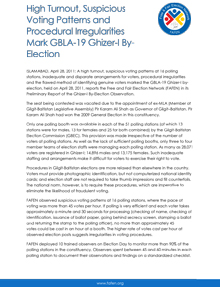ISLAMABAD, March 29, 2011: A relatively low turnout, suspicious voting pattern at 11 polling stations, relatively higher participation of women voters and procedural irregularities marked the by-election on NA-172 Dera Ghazi Khan-II held on March 29, 2011 that followed a competitive but expensive election campaign by candidates of major political parties, reports Free and Fair Election Network (FAFEN) in its Preliminary Report of the By-election observation.
The candidates were observed to have spent a lot of money on the campaign for this by-election with frequent use of expansive and sophisticated advertisement material like billboards and penaflex. Moreover, all major candidates had made elaborate arrangements for transportation of voters by hiring hundreds of public transport vehicles.
The police presence in and outside the polling stations was relatively low if compared with the by-elections held in other constituencies in near past. FAFEN observers reported an incident of violence from PS-129, where the armed body guards of a candidate resorted to aerial firing when the supporters of an opponent political party pelted stones at the vehicle of the candidate. The incident caused suspension of polling process for 15 minutes.
According to FAFEN observers reporting from 24 randomly sampled polling stations, the turnout remained 26.24 percent, which was lower than the turnout (34.31%) in the General Elections 2008. The turnout at male polling stations was recorded at 21.2 percent, 23 percent at female polling stations and 31.4 percent at combined polling stations.
FAFEN observers reported suspicious voting pattern from 14 booths of 11 polling stations where the rate of votes polled exceeded the humanly possible rate of 45 votes at a booth in an hour. At PS-3 election officials told FAFEN observers that two ballot paper books carrying 100 ballot papers each were stolen from Booth 2. Such stolen ballot papers can be used for illegal vote stuffing. At 29 polling stations, additional counterfoils had been filled on the ballot books whereas at six polling stations ballot papers were issued without filling the counterfoils, indicating the possibility of fraudulent votes being stuffed in ballot boxes.
FAFEN observers were not allowed to observe the counting process at more than five polling stations, particularly in de-excluded tribal area of the constituency.
The seat was vacated due to death of Mr. Farooq Ahmed Khan Leghari (Member of the National Assembly), who won the 2008 General Elections on PML ticket by securing 45,370 votes when the voter turnout remained 34.31%. As many as 391,071 voters are registered in NA-172 DG Khan-II; 218,829 men and 172,242 women.
The Election Commission of Pakistan (ECP) had set-up 260 polling stations – 61 male, 61 female and 138 combined polling stations. The 260 polling stations had 635 polling booths – 343 for men voters and 292 for women voters.
FAFEN deployed 43 trained observers on Election Day to monitor more than 75% of the polling stations set up in the constituency. Observers spent between 45 and 60 minutes in each polling station to document their observations and findings on a standardized checklist that is based on the provisions of the Representation of the Peoples Act 1976, Conduct of Elections Rules 1977, and instructional handbooks that the ECP has provided to election officials.
This preliminary report is based on observation of 73 polling stations – 21 male, 22 female and 30 combined. Some of FAFEN’s key findings include:
- Voter Turnout
According to FAFEN observers reporting from 24 randomly sampled polling stations, the turnout remained 26.24 percent, which was lower than the turnout (34.31%) in the General Elections 2008. The turnout at male polling stations was recorded at 21.2 percent, 23 percent at female polling stations and 31.4 percent at combined polling stations.
- Suspicious Voting Patterns
There were 14 polling booths at 11 polling stations where FAFEN observers recorded suspicious voting patterns. If the polling is most efficient and each voter is taking approximately a minute and 30 seconds for processing (checking of name, checking of CNIC, issuance of ballot paper, going behind secrecy screen, stamping a ballot and returning of stamp to the assistant presiding officer), there can be approximately 45 votes that can be cast in an hour at a booth. However, the rate of voting was higher than possible at 14 booths of 11 polling stations listed below. The following table gives booth-wise average of polled votes per hour. An average higher than 45 brings into question the speed with which the voters were being processed.
|
Polling Station |
Register Voters |
PS Type |
Time of Observation |
Average Vote per Hour at Booth 1 |
Average Vote per Hour at Booth 2 |
Average Vote per Hour at Booth 3 |
Average Vote per Hour at Booth 4 |
Total Votes Polled at the Time of Observer’s Visit |
|
PS-2 |
1942 |
F |
10:00 AM |
50 |
7 |
18 |
0 |
149 |
|
PS-105 |
1287 |
C |
2:00 PM |
51 |
21 |
0 |
0 |
436 |
|
PS-106 |
2827 |
C |
2:00 PM |
16 |
53 |
53 |
0 |
723 |
|
PS-109 |
1168 |
C |
10:00 AM |
60 |
0 |
0 |
0 |
120 |
|
PS-110 |
1883 |
C |
10:00 AM |
65 |
0 |
0 |
0 |
129 |
|
PS-112 |
2555 |
C |
9:00 AM |
170 |
120 |
0 |
0 |
290 |
|
PS-113 |
2818 |
C |
10:00 AM |
55 |
0 |
0 |
0 |
110 |
|
PS-139 |
1590 |
C |
11:00 AM |


